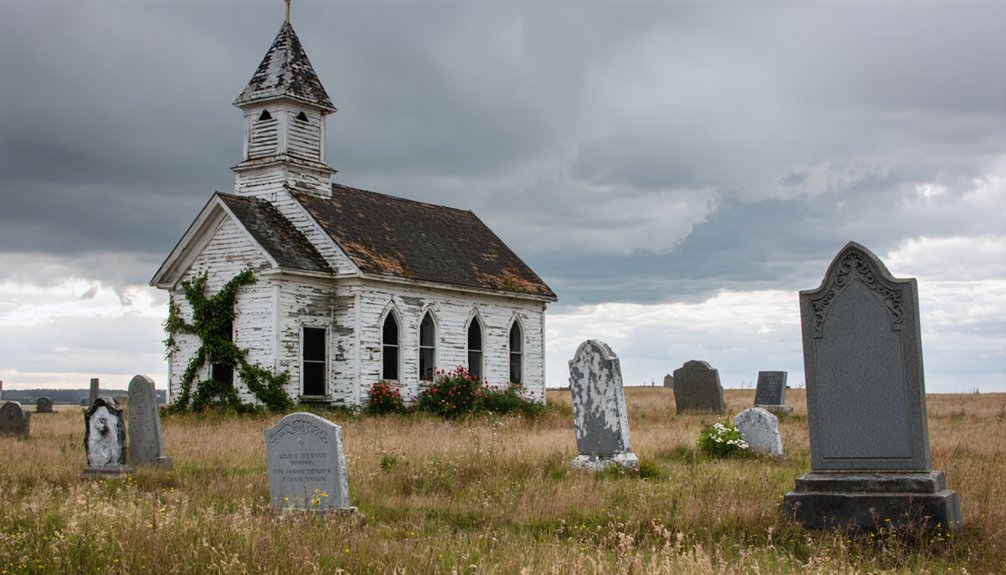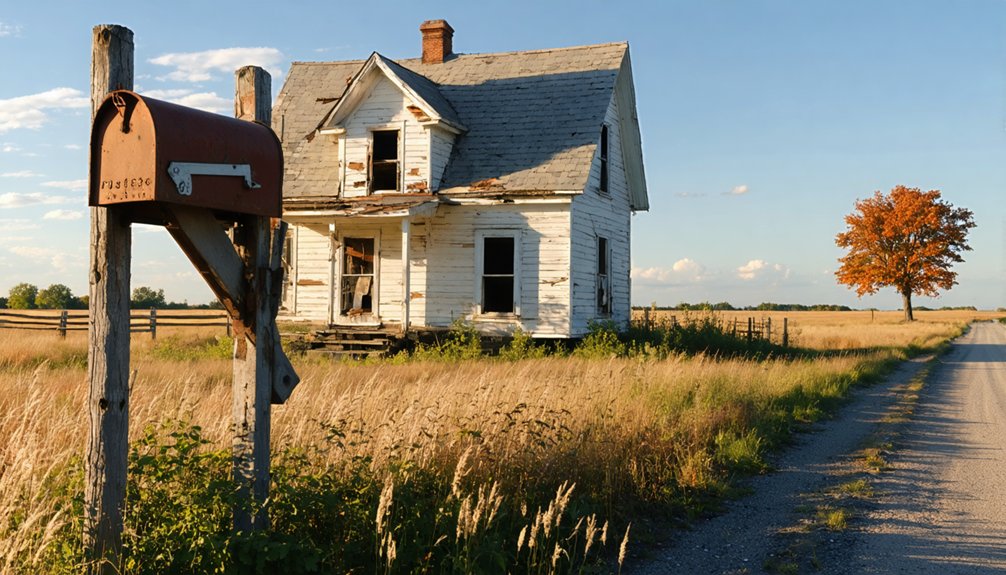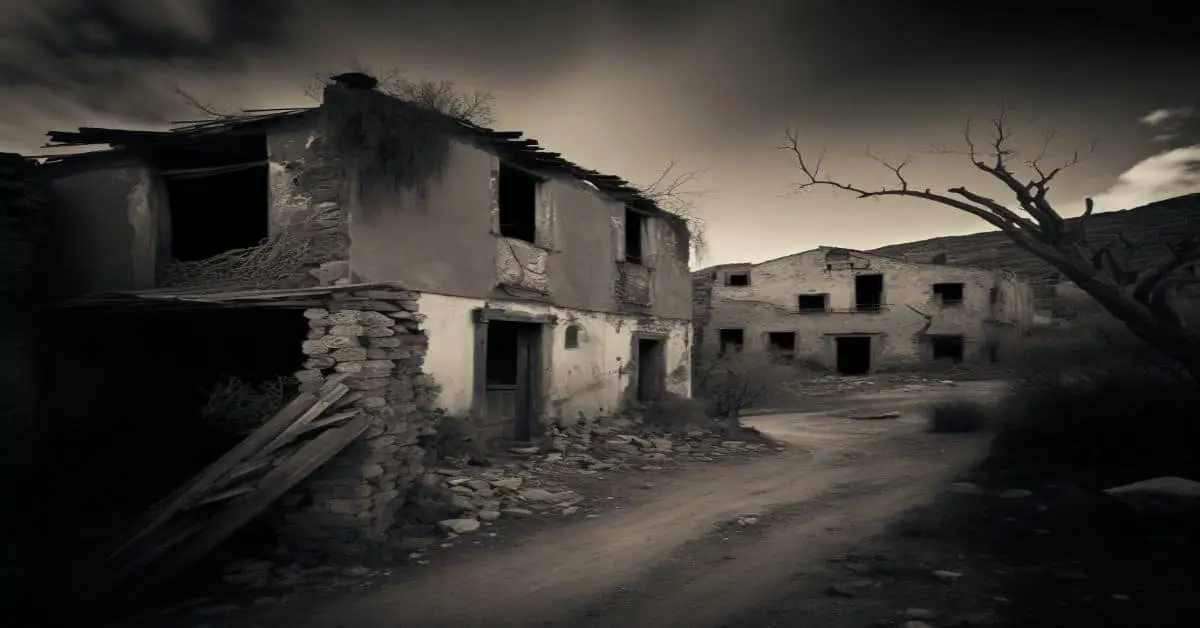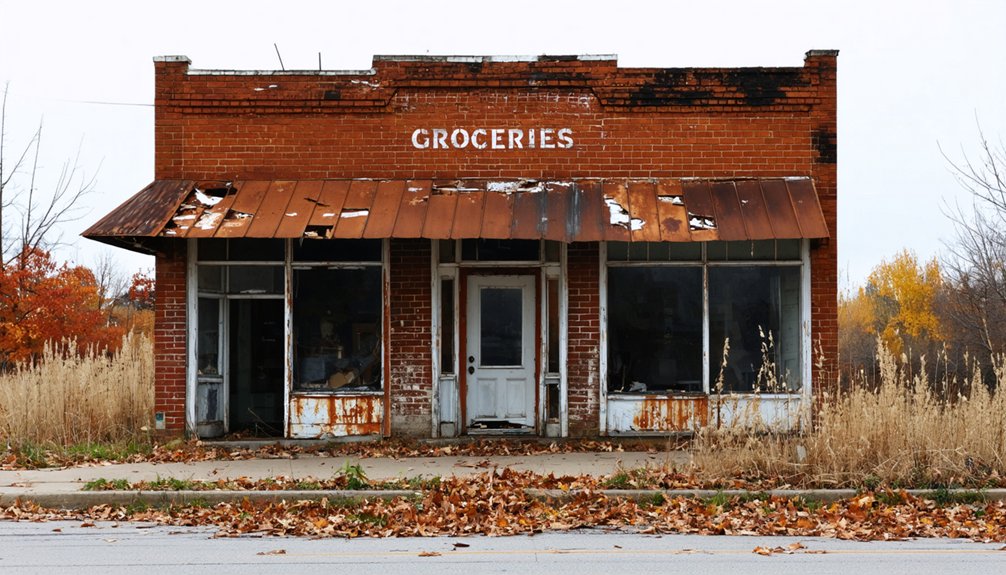You’ll find Littleport, Iowa’s haunting remains along the Turkey River, where this once-prosperous farming town flourished from its 1857 founding through the early 1900s. The community peaked at 203 residents in 1930, supported by fertile soil and a strategic railroad connection. After decades of economic decline, a devastating 1999 flood dealt the final blow, reducing the population to just 26 by 2000. Today, the abandoned site offers a poignant glimpse into Iowa’s vanishing rural heritage.
Key Takeaways
- Littleport became a ghost town after the devastating 1999 Volga River flood forced most residents to relocate.
- The town’s population drastically declined from 166 in 1910 to just 26 residents by 2000.
- Originally established in 1857, Littleport thrived as an agricultural hub with general stores, a bank, and blacksmith shop.
- Today, visitors can explore the abandoned site, which offers photography opportunities and insight into Iowa’s rural heritage.
- Former residents hold annual reunions since 2003 to preserve the town’s memories and legacy.
The Rise and Fall of a Rural Community
Although Littleport began modestly when Dennis Quigley laid out the settlement in 1857, the town’s fortunes improved dramatically with the railroad’s arrival in 1874.
Like many frontier towns, Littleport’s destiny was forever altered when steel rails connected it to the wider world.
You’ll find that this small Iowa community showed remarkable cultural resilience as it grew into a thriving rural service center, with its population reaching 203 by 1930.
Much like the town of Red Rock, which operated its school for 100 years, Littleport maintained strong educational institutions that served as pillars of the community.
The town’s community identity centered around its churches, schools, and civic organizations, creating a close-knit society that supported the local agricultural economy.
Similar to modern security systems that protect communities, the town implemented protective measures to safeguard its residents and property.
However, you’d have witnessed a stark change after the 1940s, as mechanization and rural outmigration took their toll. The population steadily declined from 139 in 1950 to just 26 residents by 2000.
Flooding near the Volga River further challenged the town’s survival, eventually leading to Littleport’s transformation into a ghost town.
Life in Early Littleport
When Dennis Quigley established Littleport in 1857, daily life revolved around agriculture and tight-knit community bonds.
You’d find families living in wooden frame houses spread across the landscape, each with barns and outbuildings essential for farming operations. The town’s heart beat through its one-room schoolhouse, general store, and post office, while churches served as centers for community gatherings and social events. Like nearby Elkport, the town relied on its south-end levee for flood protection. Similar to how Knowlton had its Maple Leaf Hotel, the town’s businesses reflected local character.
Despite limited educational resources, locals valued literacy and learning. You’d see horse-drawn wagons traveling dirt roads between homesteads, and farmers working the land according to seasonal cycles.
Life wasn’t easy – harsh winters, floods, and isolation from railroads challenged residents, but they’d overcome hardships through strong social connections and mutual support.
Economic Forces Behind the Exodus
While Littleport’s early history showed promise, the devastating Volga River flood of May 16, 1999, dealt a severe blow to the town’s already fragile economy.
You’ll find the town’s economic sustainability had been steadily weakening long before this disaster, as population trends reveal a dramatic decline from 166 residents in 1910 to just 26 by 2000. Like many small rural towns that experienced similar declines, property values plummeted when residents departed.
The lack of economic diversification left Littleport vulnerable, with its dependence on agriculture and small businesses proving insufficient to maintain a thriving community.
You’d have seen how job opportunities grew increasingly scarce, forcing residents to seek livelihoods elsewhere.
The exodus led to a domino effect: as people left, local services shut down, making the town less attractive to potential newcomers and accelerating its transformation into a ghost town. Much like Keokuk, Iowa, the town suffered from vacant storefronts that symbolized its economic deterioration.
Agricultural Heritage and Local Business
Since its incorporation in 1907, Littleport thrived as an agricultural hub nestled along the Turkey River, where fertile soil supported extensive crop farming operations.
You’d have found three general stores, a bank, and a blacksmith shop serving the needs of local farmers and residents. The Catholic church, built in 1909, became the town’s social center, while farming traditions shaped the community’s daily rhythms. Like Buckhorn’s success with its 700 patron creamery, local businesses relied on strong agricultural cooperation.
Business sustainability depended heavily on agriculture, with family-run enterprises like sawmills and wagon shops maintaining the farming equipment. Farm families retiring led to the merging of smaller properties into larger operations.
The post office and county roads connected Littleport to neighboring communities, facilitating trade and communication.
While floods and economic shifts eventually led to the town’s decline, you can still see the agricultural legacy in the surviving farmhouses and rural landscape that defines present-day Littleport.
Preserving Memories Through Reunions
After devastating floods struck the Volga River in 1999, former Littleport residents established annual reunions to preserve their shared heritage and memories.
Since the first gathering in 2003, you’ll find these events taking place near the flood’s anniversary date, serving as both social occasions and memorials to the town’s legacy.
Through community storytelling sessions, you can experience firsthand accounts of life before and after the flood.
These gatherings strengthen emotional connections as participants share photographs, memorabilia, and personal anecdotes.
Similar to Underground Railroad sites in Dalmanutha and Dale City, these reunions demonstrate how displaced townspeople maintain bonds despite being forced to move due to flooding.
Like the community of Elkport’s relocated residents, these reunions demonstrate how displaced townspeople maintain bonds despite being forced to move due to flooding.
You’ll witness how these reunions help preserve oral histories while creating lasting bonds between generations.
Former residents and their descendants maintain their cultural identity through organized tours of the town’s remnants, group meals, and occasional musical presentations that celebrate Littleport’s rich past.
Ghost Town Tourism Potential
You’ll find numerous opportunities to explore Littleport’s historical sites, including the old mill foundations and remnants of the general store that operated until 1947.
The ghost town‘s quiet streets and deteriorating structures provide compelling subjects for both amateur and professional photographers seeking to capture Iowa’s rural past.
You can join locally guided heritage tours that highlight Littleport’s role in Clayton County’s development during the late 1800s, with particular emphasis on its once-thriving milling industry.
Historical Site Exploration
While Littleport’s abandoned streets offer a haunting glimpse into Iowa’s rural past, the site’s tourism potential remains largely untapped. You’ll find this ghost town easily accessible via County Road X3C from Elkader, nestled near the convergence of the Volga and Turkey Rivers.
As you explore, you’ll witness the aftermath of community resilience tested by natural disasters, particularly the devastating 1999 flood that forced most residents to relocate.
You won’t find preserved buildings or interpretive signs, but the rolling farmland and river views tell their own story. The site’s quiet solitude invites self-guided exploration, though you should respect any remaining private property.
For history enthusiasts seeking an authentic ghost town experience, Littleport’s untouched landscape offers a raw, unfiltered connection to Iowa’s rural heritage.
Photography Opportunities Available
Despite its abandoned state, Littleport offers photographers exceptional opportunities to capture Iowa’s vanishing rural heritage.
You’ll discover rich photographic techniques to document the town’s atmospheric decay, from weathered buildings to nature’s gradual reclaim of human structures. The ghost town aesthetics provide perfect backdrops for both urban exploration and historical documentation.
- Natural lighting through broken windows creates dramatic chiaroscuro effects
- Seasonal changes offer diverse moods from autumn foliage to misty mornings
- Architectural remnants provide authentic period details for historical shots
- Macro photography reveals intricate textures in peeling paint and rusty metal
- Empty streets and overgrown paths create compelling compositional perspectives
Remember to obtain necessary permissions and stay safe while photographing, as many structures may be unstable or on private property.
The site’s accessibility from nearby highways makes it ideal for day-trip photography sessions.
Local Heritage Tours
Since its abandonment after the devastating 1999 flood, Littleport has emerged as a compelling destination for heritage tourism in Clayton County, Iowa.
You’ll discover the town’s rich history through community storytelling sessions led by former residents who gather for regular reunions, sharing tales of life before the Volga River claimed their homes.
Access the site via County Road X3C from Elkader, where heritage interpretation brings to life the story of this once-thriving community of 60 homes.
Local historical societies partner with tourism organizations to offer guided tours that blend natural beauty with cultural significance.
While physical structures are limited, you’ll experience authentic narratives of river commerce, settlement patterns, and the dramatic 1999 flood that forever changed this landscape.
Former residents and their descendants guarantee tours maintain historical accuracy and respect for community memory.
Impact on Clayton County
You’ll find Clayton County’s economic stability was greatly shaken by Littleport’s transformation into a ghost town, with the loss of property tax revenue and the elimination of a local consumer base.
The county’s heritage took a substantial hit when Littleport’s community institutions disappeared, including schools and churches that had served as cultural anchors for generations.
While the annual reunions of former residents help preserve some memories, the county has permanently lost an important piece of its historical fabric and commercial potential.
Economic Ripple Effects
As Littleport transformed into a ghost town, its economic decline sent devastating ripples throughout Clayton County’s economy.
The area’s community resilience was tested as property values plummeted, businesses shuttered, and tax revenues dwindled.
You’ll find the impact particularly evident in these key areas:
- Household incomes dropped to $23,125, while poverty rates climbed to 15.8%
- Empty storefronts and abandoned properties created a snowball effect of decreasing real estate values
- The aging population (42.3% over 65) severely limited the available workforce
- Public services struggled with reduced funding, leading to cutbacks in roads and utilities
- Local businesses faced financing challenges due to devalued property assets
The county’s economic identity shifted as investment moved toward larger urban centers, making recovery increasingly difficult for remaining residents and entrepreneurs.
Local Heritage Loss
The devastating loss of Littleport’s cultural heritage in 1999 created permanent wounds in Clayton County’s historical fabric.
You’ll find that when the Volga River flooded, it didn’t just wash away buildings – it erased generations of community identity. The federal government’s acquisition of remaining homes after the flood severed the town’s cultural significance, disrupting how local customs and stories passed from one generation to the next.
Today, you won’t see the once-vibrant landmarks that anchored Littleport’s social life. The post offices, stores, and gathering spaces that defined the community have vanished.
While former residents still hold reunions to preserve their shared memories, the physical connections to their heritage have largely disappeared, weakening Clayton County’s ability to maintain its historical narrative through living, breathing examples of its past.
Legacy of an Iowa Settlement

Despite its physical disappearance from Iowa’s landscape, Littleport’s legacy endures through the collective memory of its former residents and their descendants. This Clayton County settlement, though challenged by the volatile Volga River, demonstrated remarkable community resilience until nature forced adaptation in 1999.
You’ll find that Littleport’s story lives on through shared experiences and documented histories.
- The 2003 reunion brought scattered residents back together, proving community bonds transcend physical location.
- Former residents’ oral histories preserve the town’s rich agricultural heritage.
- Local historians continue documenting Littleport’s role in northeastern Iowa’s development.
- The town’s environmental struggles mirror other Iowa settlements like Elkport.
- Littleport’s experience informs modern discussions about community adaptation to natural challenges.
Frequently Asked Questions
What Is the Current Population of Littleport, Iowa?
You’ll find Littleport’s current demographics show virtually zero residents, down from 26 in 2000. The town history reveals a steady decline from 166 residents in 1910 to ghost town status today.
Are Any Original Buildings From Historic Littleport Still Standing Today?
While historic preservation and building restorations weren’t possible due to severe flooding, you won’t find any original buildings standing today – they’ve all been demolished through federal buyouts and flood damage.
When Was the Last Official Town Reunion Held in Littleport?
The last official town reunion was held in 2003, marking a significant moment in town history when former residents gathered to celebrate their community’s legacy following the devastating 1999 floods.
What Religious Institutions or Churches Existed in Early Littleport?
You’ll find limited historical records, though there was likely a Methodist Church serving early settlers. No confirmed Catholic congregation existed, reflecting typical religious patterns of small Iowa frontier towns.
Did Littleport Ever Have a Post Office or Railroad Station?
Through dusty records and faded time, you’ll find Littleport’s post office history was brief, operating only from 1843-1845. You won’t discover any railroad station ever existing there.
References
- https://khak.com/ghost-town-what-happened-to-elkport-iowa/
- https://www.youtube.com/watch?v=rk9_9xAYirw
- https://jackandkitty.com/iowa-ghost-towns/
- https://www.discoverguthriecounty.org/ghosttowns
- https://www.crawfordcounty.iowa.gov/about/forgotten_towns/
- https://www.radioiowa.com/2003/05/19/littleport-residents-hold-a-reunion/
- https://en.wikipedia.org/wiki/List_of_ghost_towns_in_Iowa
- https://www.ruralhistorybuffs.org/lost-towns
- https://pubs.lib.uiowa.edu/annals-of-iowa/article/id/13329/download/pdf/
- https://www.wikiwand.com/en/articles/Littleport



